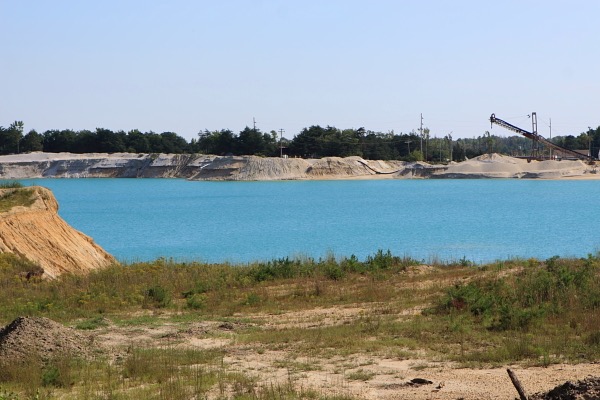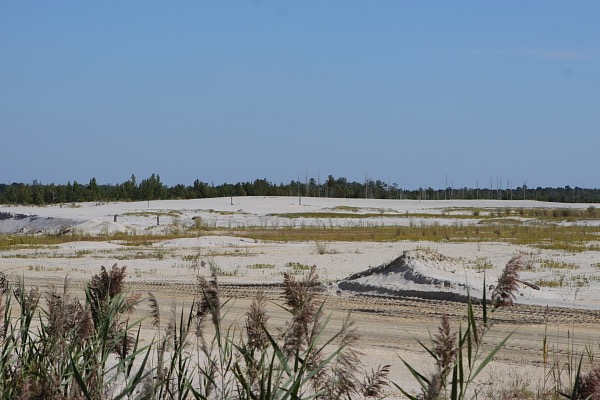Mining Industry Sought Regulatory Relief – And The Commission Gave It To Them
A Bright Green Light To Expand Mining In The Pinelands
Murphy DEP Supported The Mining Industry’s Attack On Pinelands Regulatory Proposal
This might be hard to believe, but the NJ Pinelands Commission just explicitly sought, in their words:
to avoid unintended negative impacts on the resource extraction industry
Let me explain that.
Way back in 2001, in response to over-development threats and a growing water crisis on the Cape May County Penninsula (e.g. salt water intrusion, need for costly new desalination plants, pending major new development, etc), the Legislature enacted a law (named the “Gibson bill” for a local legislator) that essentially established a moratorium on additional DEP water withdrawal permits for new development until scientific studies were completed to determine how much water was available.
Those studies also included the Pinelands:
New Jersey Public Law 2001, Chapter 165 directed the Pinelands Commission to assess and prepare a report on the key hydrologic and ecological information needed to determine how the current and future water-supply needs within the Pinelands area may be met while protecting the Kirkwood-Cohansey aquifer system and avoiding any adverse ecological impact on the Pinelands area.
After more than 20 years, the studies were completed and the Pinelands Commission finally proposed new regulations to require consideration of the ecological impacts and limits on water allocation that would create unacceptable ecological impacts.
The rules were proposed on September 6, 2022:
The proposed amendments require applicants for diversions in the Kirkwood-Cohansey aquifer to conduct specific tests, analyses, and modelling to demonstrate whether the proposed diversion will have an adverse regional or local impact.
To protect the more ecologically sensitive areas of the Pinelands Area, the Commission is proposing to limit new or increased diversions from the Kirkwood-Cohansey aquifer to the Agricultural Production Area and the more growth-oriented Pinelands Management Areas. In addition, a diversion will only be permitted if an applicant can demonstrate that no alternative water supply source is available or viable.
Here’s visually what’s at stake (along with a good article – photo from our friend Al Horner, YaleEnvironment360)
Almost before the ink was dry on the proposed new rules, the sand mining industry went ballistic and frontally attacked the proposal.
These mining guys were not subtle and made direct and over the top political threats:
It is our feeling, if adopted as currently written without clarification, the industry will have to cut production by 50%. This will lead to a huge shortage, only exacerbating the current shortage and will threaten the contractors in our state’s ability to complete vital DOT projects such as bridges, highways and local roads. In addition to a lack of materials, the shortage from these regulations could mean a doubling in material price. Given the current inflationary environment we live in today, these regulations, as currently written, will threaten the New Jersey Department of Transportation’s Capital Program. ~~~ Source:William Layton, New Jersey Concrete and Aggregate Association. 11/4/22 – You may contact him at bill@clbnj.com
On November 3, 2022, the sand mining industry submitted ballistic comments – backed by written comments from the law firm Connell Foley and the notorious pay-to-play politically connected toxic polluter defense firm Langan Engineering – that claimed that the Pinelands Commission had no legal authority to regulate water withdrawals and that the proposal was fatally flawed technically.
I don’t want to go into the details here (will in a future post), but will provide their comments upon request.
The point is, the Pinelands Commission immediately folded. Immediately. This is an historic fold.
The previous time the Murphy DEP folded to the fossil Fuel Merchants Association, NJBIA, and Petroleum Council’s opposition to recent boiler replacement electrification requirements, at least they waited for bad press and an industry lobbying campaign that targeted Gov. Murphy to emerge. This fold was immediate. Gov. Murphy nixed it before the industry criticism could even be deployed!
You can read the Commission’s fold and response to the sand industry criticisms.
The Commission gave the sand mining industry virtually everything they demanded – and they literally “thanked” them for it – including effectively grandfathering all existing mining operations from the new requirements (emphasis mine):
During the public comment period on the original notice of proposal, the Commission received comments expressing concern regarding the impact of the proposed amendments on the resource extraction industry in the Pinelands Area. Resource extraction in the Pinelands Area involves mining sand and gravel, typically by mechanical or hydraulic dredging, a process that uses water directly from water bodies created by excavations below the water table of the Kirkwood-Cohansey Aquifer. …
The Commission thanks the resource extraction industry for its comments regarding the specific nonconsumptive uses of water for hydrologic dredging operations. Given that there are over 70 existing resource extraction operations in the Pinelands Area, approximately half of which are located in the Preservation Area District and Forest Area where the proposed rule would prohibit new diversion of over 50,000 gallons of water per day or more from the Kirkwood-Cohansey Aquifer, the industry has raised valid concerns about the impact of the proposed rule.
In order to avoid unintended negative impacts on the resource extraction industry, the Commission is proposing a new provision at N.J.A.C. 7:50-6.86(d)2iii, which states that the standards at N.J.A.C. 7:50-6.86(d)3 through 9 will not apply to proposed diversions for resource extraction operations that constitute a non consumptive use, provided that the water returned to the source is not discharged to a stream or waterbed or otherwise results in offsite flow, and the diversion and return are located on the same parcel.
Did you get that? Let me repeat exactly what drove the Pinelands Commission’s decision to fold:
In order to avoid unintended negative impacts on the resource extraction industry,
So, the Commission just agreed to allow more landscapes like this one in the photo below for the Pinelands’ future.
Thanks to the extractive mining industry and the cowardice and neglect of the Pinelands Commission.
Send Gov. Murphy, who appointed the Commission “leadership” who did this irresponsible sellout your thoughts.
In my next post, I will explain how the Murphy DEP submitted comments that were critical of the Pinelands Commission’s proposal, legally and scientifically undermined that proposal, and agreed with the mining industry.
[End Note: I originally published this photos of Pinelands mining operations back in 2009 (with awesome shots of a timber rattlesnake!)





Pingback: WolfeNotes.com » The Murphy Administration Is Abandoning And Watering Down Climate And Environmental Protections Based On Bogus Economic Arguments
Pingback: WolfeNotes.com » Pinelands Commission Staff Held A Private Meeting With Mining Industry Lobbyists – That Meeting Led To Rollback Of Water Regulations